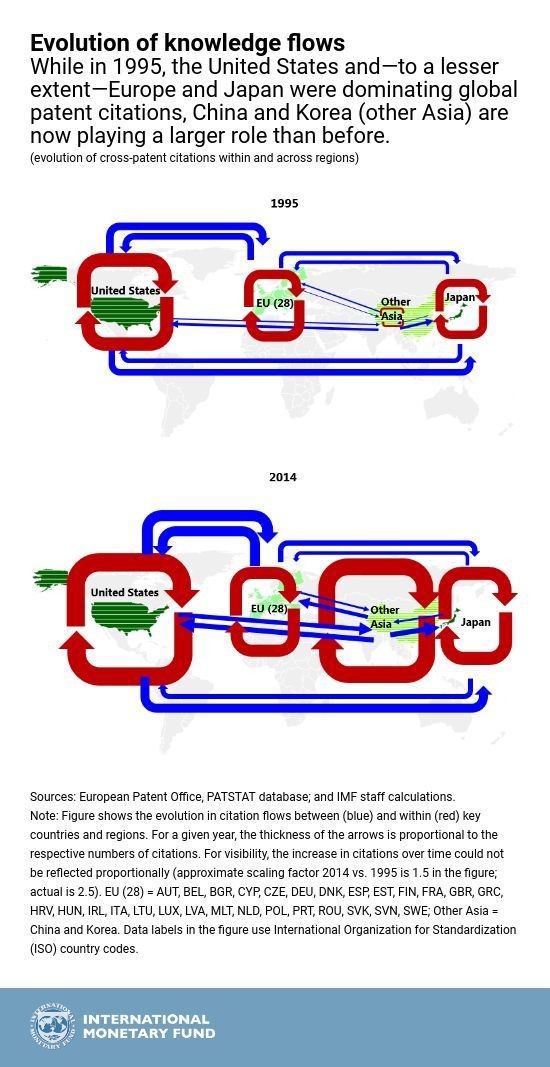This is the major impact globalization has had on productivity

Globalization has allowed knowledge and technology to spread much quicker. Image: REUTERS/Toby Melville
It took 1,000 years for the invention of paper to spread from China to Europe. Nowadays, in a world that has become more integrated, innovations spread faster and through many channels.
Our research in Chapter 4 of the April 2018 World Economic Outlook takes a closer look at how technology travels between countries. We find that the spread of knowledge and technology across borders has intensified because of globalization. In emerging markets, the transfer of technology has helped to boost innovation and productivity even in the recent period of weak global productivity growth.
Why spreading technology matters
Technological progress is a key driver of improvements in incomes and standards of living. But new knowledge and technologies do not necessarily develop everywhere and at the same time. Therefore, the way technology spreads across countries is central to how global growth is generated and shared across countries.
Indeed, during 1995–2014, the United States, Japan, Germany, France, and the United Kingdom (the G5) produced three-fourths of all patented innovations globally. Other large countries—notably China and Korea—have started to make significant contributions to the global stock of knowledge in recent years, joining the top five leaders in a number of sectors. While this suggests that in the future they too will be important sources of new technology, during the period under study, the G5 constituted the bulk of the technology frontier.
To trace knowledge flows, our study uses the extent to which countries cite patented innovations from the technology leaders as prior knowledge in their own patent applications. The chart below gives a representation of these cross-country knowledge links. Two features stand out. First, while in 1995 the United States, Europe, and Japan were dominating global patent citations, China and Korea (depicted together as “other Asia”) have made increasingly large use of the global knowledge stock as measured by their patent citations. Second, knowledge links have in general intensified over time, both within (red arrows) and across (blue arrows) regions. An alternative measure for the extent to which foreign knowledge is available for domestic use is the intensity of international trade with technology leaders—and our study looks at this as well.
Globalization boosts technological development
The increasing intensity of global knowledge flows points to important benefits of globalization. While globalization has been much criticized for its possible negative side effects, our study shows that globalization has amplified the spread of technology across borders in two ways. First, globalization allows countries to gain easier access to foreign knowledge. Second, it enhances international competition—including as a result of the rise of emerging market firms—and this strengthens firms’ incentives to innovate and adopt foreign technologies.
The positive impact has been especially large for emerging market economies, which have made increasing use of the available foreign knowledge and technology to boost their innovation capacity and labor productivity growth. For instance, over 2004–14, knowledge flows from the technology leaders may have generated, for an average country-sector, about 0.7 percentage point of labor productivity growth per year. This amounts to about 40 percent of the observed average productivity growth over 2004–14. We find that one important factor behind the build-up of innovation capacity in emerging market economies has been their growing participation in global supply chains with multinational companies, though not all firms have benefitted as multinationals sometimes reallocate some innovation activity to other parts of the global value chain.

The increased transfer of knowledge and technology to emerging market economies has partly offset the effects of the recent slowdown in innovation at the technology frontier and helped drive income convergence for many emerging economies. In contrast, advanced economies have been more affected by the technology slowdown at the frontier.
Finally, our study finds evidence that technology leaders themselves benefit from each other’s innovation. This suggests that, going forward, with the growing contribution of China and Korea to the expansion of the technology frontier, there may be scope for positive spillovers from these new innovators to the traditional innovators. Knowledge and technology do not flow in one direction only.
Spreading the know-how
Globalization brings a key benefit—it stimulates the spread of knowledge and technology, helping spread growth potential across countries. But interconnectedness per se is not enough. The assimilation of foreign knowledge and the capacity to build on it most often requires scientific and engineering know-how. Investments in education, human capital, and domestic research and development are thus essential to build the capacity to absorb and efficiently use foreign knowledge. It also requires an appropriate degree of protection and respect of intellectual property rights—both domestically and internationally—to preserve the ability of innovators to recover costs while ensuring that the new knowledge supports growth globally.
Policymakers must also make certain that the positive growth benefits from globalization and technological innovation are shared widely across the population, including by ensuring that innovating firms do not exploit the newly acquired technology to gain excessive control of a market to the detriment of consumers.
Don't miss any update on this topic
Create a free account and access your personalized content collection with our latest publications and analyses.
License and Republishing
World Economic Forum articles may be republished in accordance with the Creative Commons Attribution-NonCommercial-NoDerivatives 4.0 International Public License, and in accordance with our Terms of Use.
The views expressed in this article are those of the author alone and not the World Economic Forum.
Stay up to date:
Digital Communications
Related topics:
Forum Stories newsletter
Bringing you weekly curated insights and analysis on the global issues that matter.
More on Global CooperationSee all
Sebastian Buckup and Maximilian Martin
November 13, 2025







